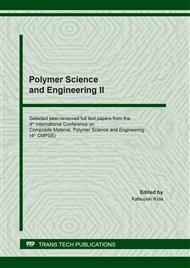[1]
H. X. D. Lee, H. S. Wong and N. R. Buenfeld, Self-sealing of cracks in concrete using superabsorbent polymers,, Cement & Concrete Research, Vol. 79, pp.194-208, (2016).
DOI: 10.1016/j.cemconres.2015.09.008
Google Scholar
[2]
Z. Chen, M. Liu and S. Ma, Synthesis and modification of salt-resistant superabsorbent polymers,, Reactive and Functional Polymers, Vol. 62, No. 1, pp.85-92, (2005).
DOI: 10.1016/j.reactfunctpolym.2004.09.003
Google Scholar
[3]
M.R. Islam, X. Xue, S. Li, Effectiveness of Water-Saving Superabsorbent Polymer in Soil Water Conservation for Oat Based on Ecophysiological Parameters,, Commun Soil Sci. Plan Anal., Vol. 42, p.2322–2333, (2011).
DOI: 10.1080/00103624.2011.605490
Google Scholar
[4]
E. Calo and V. V. Khutoryanskiy, Biomedical applications of hydrogels: A review of patents and commercial products,, European Polymer Journal, Vol. 65, pap. 252-267, (2015).
DOI: 10.1016/j.eurpolymj.2014.11.024
Google Scholar
[5]
E. M. Ahmed, Hydrogel, Preparation, characterization, and applications: A Review,, J. of Advance Research, Vol. 6, pp.105-121, (2015).
Google Scholar
[6]
X. P. Chen, G. R. Shan, J. Huang , Z. M. Huang , Z. X. Weng, Synthesis and properties of acrylic based superabsorbent,, Vol. 92, No. 1, pp.619-624, (2004).
DOI: 10.1002/app.20052
Google Scholar
[7]
K. M. Raju, M. P. Raju, Y. M. Mohan, Synthesis and Water Absorbency of Crosslinked Superabsorbent Polymers,, Journal of Applied Polymer Science, Vol. 85, p.1795–1801, (2002).
DOI: 10.1002/app.10731
Google Scholar
[8]
W.F. Lee and Y. M. Tu, Superabsorbent polymeric materials. VI. Effect of sulfobetaine structure on swelling behavior of crosslinked poly(sodium acrylate‐co‐sulfobetaines) in aqueous salt solutions,, Journal of Applied Polymer Science, Vol. 72, No. 9, pp.1221-1232, (1999).
DOI: 10.1002/(sici)1097-4628(19990531)72:9<1221::aid-app11>3.0.co;2-c
Google Scholar
[9]
C. Jiang, X. Cao L. and Guo, (2016), Synthesis and swelling behavior of poly (acrylic acid-acryl amide-2- acrylamido-2-methyl-propansulfonic acid) superabsorbent copolymer,, J. of Petroleum Exploration and Production Technology, Vol. 7, No. 1, pp.69-75, (2016).
DOI: 10.1007/s13202-016-0237-7
Google Scholar
[10]
A. Melendres, J.A. Antang and J. Manacob, Investigation of Superabsorbent Polymer Absorbency at Reduced Chemical Potential of Water,, MATEC Web of Conferences, 268, 04010, (2019).
DOI: 10.1051/matecconf/201926804010
Google Scholar
[11]
D.P. Benz and R.A. Synder, Protected paste volume in concrete: extension to internal curing using saturated lightweight fine aggregate,, Cement and Concrete Research, Vol. 29, 1863-1867, (1999).
DOI: 10.1016/s0008-8846(99)00178-7
Google Scholar
[12]
D.P. Benz, P. Lura, and J.W. Robers., Mixture Proportioning for Internal Curing,, Concrete International, pp.35-40, (2005).
Google Scholar
[13]
G. Rodriguez de Sensale and A. F. Gonclaves, Effects of Fine LWA and SAP as Internal Water Curing Agents, ,International Journal of Concrete Structures and Materials, Vol 8, pp.229-238, (2014).
DOI: 10.1007/s40069-014-0076-1
Google Scholar
[14]
C. C. Gifta, S. Prabavathy and G. Y. Kumar, Study on the internal curing of high performance concrete using superabsorbent polymers and light weight aggregates,, Asian Journal of Civil Engineering (BHRC), Vol. 14, No. 5, pp.773-781, (2013).
Google Scholar
[15]
M. Sivaranjani, Study on the properties of concrete by using superabsorbent polymer,, Materials Science Published,.
Google Scholar
[16]
K. Chandramouli, P. Srinivasa Rao, T. Seshadri Sekhar, N. Pannirselvam, and P. Sravana, Rapid chloride permeability test for durability studies on glass fiber reinforced concrete,, ARPN Journal of Engineering and Applied Sciences, Vol. 5, No. 3, pp.1819-6608, (2010).
Google Scholar
[17]
M. J. Mwiti, Chloride Ingress Resistance in Selected Calcined - Clay - Portland Cement Blends, , International Journal of Scientific Engineering and Research (IJSER), Vol. 2, No. 4, 2347-3878, (2014).
Google Scholar
[18]
B. Bhattacharjee, Some issues related to service life of concrete structures,, Indian Concrete Journal, Vol. 86, No. 1, pp.23-29, (2012).
Google Scholar
[19]
J. Piérard, V. Pollet, and N. Cauberg, Mitigating Autogenous Shrinkage in HPC by Internal Curing using Superabsorbent Polymers,, International RILEM Conference on Volume Changes of Hardening Concrete: Testing and Mitigation, Technical University of Denmark, Lyngby, Denmark, 20-23, (2006).
DOI: 10.1617/2351580052.011
Google Scholar
[20]
K. Byfors, Influence of silica fume and flyash on chloride diffusion and pH values in cement paste,, Cement and Concrete Research, Vol. 17, No. 1, pp.115-130, (1987).
DOI: 10.1016/0008-8846(87)90066-4
Google Scholar
[21]
U. Angst, B. Elsener, C. K.Larsen, O.Vennesland, Critical chloride content in reinforced concrete - A review,, Cement and Concrete Research, Vol. 39, 1122-1138, (2009).
DOI: 10.1016/j.cemconres.2009.08.006
Google Scholar
[22]
A.A. Ramezanianpour, A. Pilvar, M. Mahdikhani, F. Moodi, Practical evaluation of relationship between concrete resistivity, water penetration, rapid chloride penetration and compressive strength,, Construction and Building Materials, Vol. 25, No. 5, pp.2472-2479, (2011).
DOI: 10.1016/j.conbuildmat.2010.11.069
Google Scholar
[23]
K. Lejcu´s, M. Spitalniak and J. Dabrowska, Swelling Behaviour of Superabsorbent Polymers for Soil Amendment under Different Loads,, Polymers,.
DOI: 10.3390/polym10030271
Google Scholar
[24]
Y. Tan, H. Chen, Z. Wang, C. Xue , and R. He, Performances of Cement Mortar Incorporating Superabsorbent Polymer (SAP) Using Different Dosing Methods,, Materials, Vol. 12, No. 10,.
DOI: 10.3390/ma12101619
Google Scholar
[25]
T. V. Mullem, R. Caspeele , and N. De Belie, The influence of SAPs on chloride ingress in cracked concrete,, MATEC Web of Conferences, 289, 08007, (2019).
DOI: 10.1051/matecconf/201928908007
Google Scholar
[26]
A. A. Baba, F. A. Adekola, O. E. Shobabde, M. K. Ghosh, K. I. Aynlac and S. A. Adebayo, Chemical Hydration by Acid Leaching of a Brand of Cement in Nigeria Market,,. Int. J. Chem. Sci, Vol. 9, No. 3, pp.1534-1544, (2011).
Google Scholar
[27]
S. Kashef, Y. Shao and S. Ghoshal, Mathematical modeling of CO2 uptake by concrete during accelerated carbonation curing,,. Cement and Concrete Research, Research 67, 10.1016, (2015).
DOI: 10.1016/j.cemconres.2014.07.020
Google Scholar
[28]
S. M. PALMQUIST, E. KINTZEL, K. ANDREW, Scanning Electron Microscopy to Examine Concrete with Carbon Nanofibers,, 5th Pan American Conference for NDT, Cancun, Mexico, (2011).
Google Scholar


